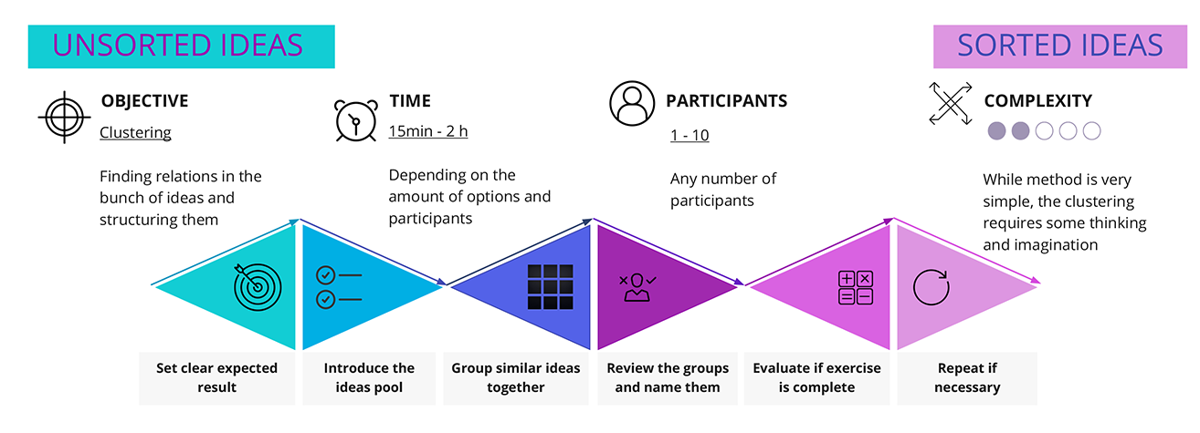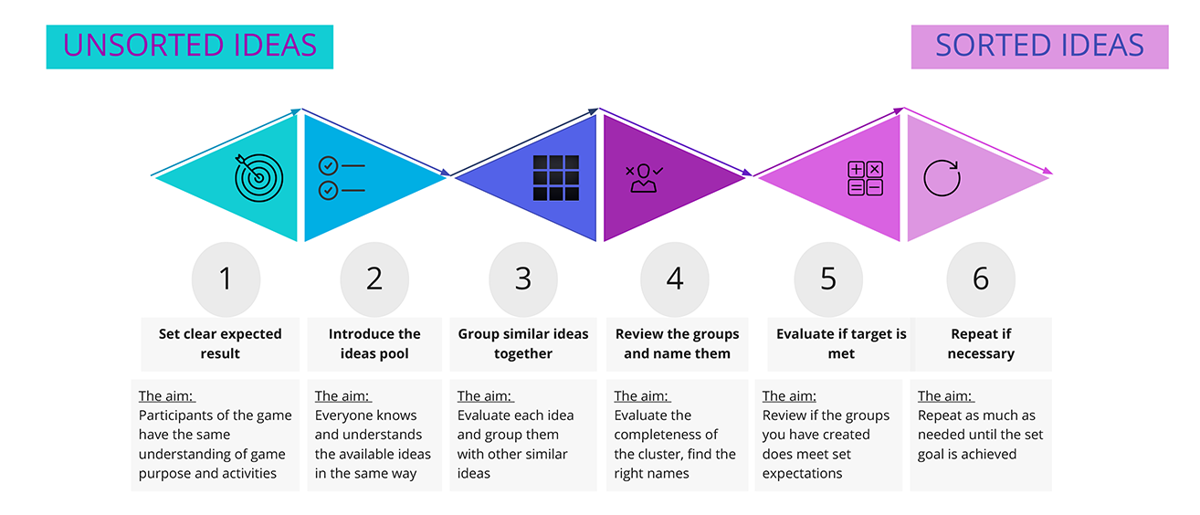"Affinity clustering" method – HOW does it work and WHAT value does it add

Reading lengths: 20min;
Method: Affinity Clustering;
Content: Method desription;
Complexity: Moderate;
Keywords: #clustering;
#grouping;
#similarities; #sets and subsets;
#characteristics; #actions; #ideas;
This article will describe one of the precious design thinking methods that is irreplaceable when there are plenty of ideas to work with. Affinity clustering or also called affinity mapping, grouping. In contrast to most design thinking methods oriented on opening new potential, affinity clustering is precisely the opposite – it is oriented towards narrowing the attention scope and replacing individual ideas with clusters of similar ideas. Such narrowing is essential in the creative process. Are you surprised why? Because while you and your team are in the discovery phase, you have the purpose of generating as many new ideas as possible. Yet when sessions end with hundreds of new ideas, that could become a problem too since choosing the focus point for the subsequent actions will become more problematic. What you can do, though, is to smartly group and cluster ideas and make the scope manageable again. Further in this article, I’ll write about how to do it.
Why are grouping and clustering so important?
Imagine you are at the creative session together with eight other people. The purpose of the session is to generate ideas about supporting new moms when they return to the workplace. There are a diverse group of participants in your workgroup – there are women, men, parents, and people who enjoy their freedom. You have spent the last half an hour discussing different difficulties new moms face and have generated plenty of ideas on how to help them return to the workplace. Your workgroup members have come up with an average of fifteen different ideas each. So right now, one hundred and twenty ideas are steering at you from the whiteboard and are asking – what do we do next? Do you feel satisfied with the creativity you reached, or are you terrified about what to do next?
A situation like this is frequent in the creative process and signals that you have had a very successful session. In ideas generation, we don’t limit the number of ideas that are produced. As more new ideas emerge, as better. Design thinking process facilitators should be striving for quantity and not be terrified by the potential overload of information. Moreover, the more diverse the group you will be working with, the more varied ideas will be generated. Some of the ideas will be about close topics, but many of them will be the opposite. Some of the ideas will focus on what to do, but some will focus on what to avoid. Some will be new characteristics, some will be new actions, but others will signal future research needs. Thereby it’s going to be impossible to compare them and rank them. It’s not the place where to start voting as well. First of all, it’s impossible to remember one hundred and twenty ideas at first. Second – how will you vote on similar ideas, which one to pick for voting?
So you will have to normalize the scope of ideas before you proceed with any further actions. And ideas clustering or grouping is an excellent way how to do it. The next chapter will describe the considerations and steps you need to take to get most of the clustering activity.
But before we get into the practical details, I want to highlight that the approach is valuable in a broader set of situations than the brainstorming example I’ve described above. There are a much broader set of circumstances where we face the problem of too much information to process it efficiently—for example, client support, training, manufacturing, and others. And the affinity clustering method is here to be used in any of these situations. The only thing you have to do is to follow the steps written below.
Method description

-
Purpose: Define clear expected results
Before starting, it’s fundamental to understand the output you expect from the clustering. Very often, it’s going to be a simple grouping of repeating or similar ideas. However, it could be more specific. Maybe you will benefit more from groups made of specific grouping criteria: it can be actions, characteristics, perhaps communication sources, or roles involved in the process execution, and more. If there are any characteristics of the groups you want to apply, you need to formulate them initially.
Another point to consider - how many groups are you ready to accept for further development? If you are not afraid of many small groups, you can limit the maximum number of ideas per group. For example, if the group limit is five ideas, the workgroup will need to keep thinking and splitting ideas into smaller clusters until there is no cluster with more than five ideas. Why to complicate it, you might be thinking? The advantage is in creative thinking and looking for more connections and characteristics. For example, instead of one big cluster, “Client support ideas,” you can get three smaller clusters – “Client needs personalization,” “Video support,” and “Automated client support”. I think you will agree that the three detailed groups are more precise and better describe the uniqueness of ideas in the cluster. So it might be worth it. -
Purpose: Explain the choices
Before you start with clustering, of course, you need to be aware of and understand all elements that you are going to cluster. These choices need to be visible and understood.
And more importantly – understood in the same manner by all people. For example, if one of the choices says “Provide training,” – do all participants understand the same way what kind of training it is supposed to be? If one of the workgroup participants will imagine six months of classroom training and another will think about two hours of online training, these are different ideas that might raise issues once you work on the clusters. If you look at the training as one big cluster, that might work well. But, if you need to split it into more distinct sets, for example, ideas requiring lots of investment and quick wins, that will become a problem. -
Purpose: Group similar ideas together
When you are done with the purpose, rules, and ideas unquestionably, you can start clustering.
Start with taking the first idea and putting it in the blank area on the workspace. It is going to be your first idea in the first cluster. Then, take the second idea and ask everyone if this idea is somewhat similar to the previous one. If the idea seems similar, you can place it next to the first one (your first cluster will have two ideas now) and continue with next ideas. Yet, if it seems different, put it on another blank area. Then it’s going to be your first idea in the second cluster.
Continue in the same manner until all ideas are grouped with other somehow similar ideas. Often will have a couple of ideas standing solely from others and not having similar ideas around them. Depending on your purpose and target, these ideas can remain as solo stars, or you can group them in one cluster. -
Purpose: Review the clusters and name them
Review all of the clusters one by one.
Read all ideas in the cluster and make sure all participants agree that all ideas belong to this cluster. If any participants have doubts or questions, express them loudly and discuss with the whole group. You are done when everyone in your workgroup accepts all clusters and ideas they contain.
Your next task is to come up with the best name for the cluster. Depending on the ideas in the cluster, the name might be obvious, or it might be more challenging to find the best match. If so, discuss what all ideas in the cluster have in common? What characteristics, actions, roles, belonging to functions, etc. they share? Look for the similarities until you have found the proper naming and everyone does agree with it.
I want to stress that cluster names like “Other”, “Solution 1”, “Solution 2” and “Mixture” are not the best namings and try to avoid them at all costs. Finding the right name is not only about picking up the right word, but it also is about deep-diving in the ideas and analyzing, understanding them. So keep looking. Sometimes you may need to split the existing cluster into smaller clusters to find the right set.
Once all of the groups have its name, you can proceed to the next step. -
Purpose: Evaluate if the target is achieved
Review each cluster and make sure they satisfy the criteria set in the beginning, if any.
Do grouped ideas meet the criteria? Aren’t groups too big or too small? Even if there were no concrete maximum number of ideas presented, it still is suggested not to keep more than ten ideas in one group. If there are more than ten ideas, you can most probably split these ideas into smaller clusters. Consider if it would be worth doing so. -
Purpose: Vote if necessary
Congratulations, you narrowed your focus points and made groups of similar ideas. That is a good step ahead. Most probably, you will continue working with just one of the groups in your upcoming sessions. Maybe the one that seems the most worthy? Or perhaps the one that will require less investment or time to implement? Or maybe quite the opposite – maybe you will continue the actions with seemingly the most complex one, with the hope to gain the most prominent advantage? To decide, you will need to choose the one group meeting your aim the most. And how to do it? Of course, with voting. If you need a reminder of how to do the voting – you can find it in this article.
When to use this method?
I suggest using this method in all cases when you have at least ten different options in front of you, and you can’t decide what to do with them. If you are unsure which one to start with, how to sort them, and how to prioritize them, clustering can be go-to method. Too many choices tend to paralyze us and require over-thinking, rethinking, modeling, futurizing and doubting. To save your time and energy, merge the list of options and make clusters out of them. Clustering will help not only when you need to find similarities in ideas. You can also use the method to group ideas into categories “urgent”, “important, “maybe”, “most probably not”.
Professional field
- Working with ideas after brainstorming sessions;
- Solutions clustering after scenarios modeling sessions;
- Working with client feedback after training sessions;
- Risks and issues sorting after internal audits or reviews;
- Client feedback processing;
- Qualitative reviews;
- etc.
Personal field
- Working with ideas after brainstorming sessions;
- Reorganizing ideas, solutions, and themes;
- Games with children (creative clusters finding);
- etc.
When not to use this method?
There is no value to using this method when there is no need to merge ideas, and all ideas require one-by-one assessment and actions. Also, when the sequence of actions is precise and can’t be changed. One of the advantages of the methods is to make an inoperable set more operable. When you don’t need it, you don’t need it.
Did you like this method and the description of it?
Do give me a note about it.
I will appreciate it if you include in your message what you did like, what you think should be improved, and of course, any other ideas that would be worth experimenting with.
Maybe you want to join me in some of the method experiments?
Do you have interest or experience in this method usage?
I would love to hear your example. Let me know.